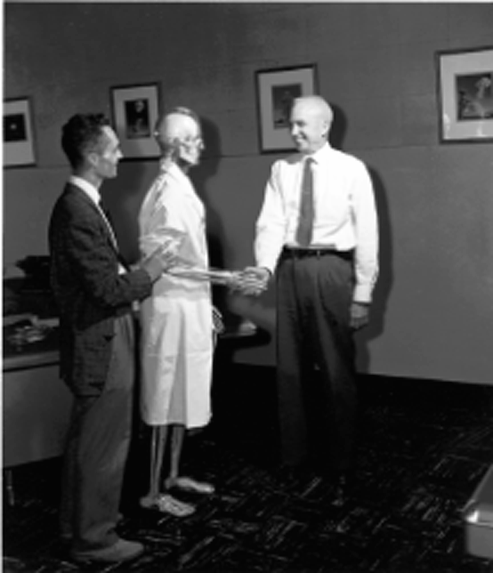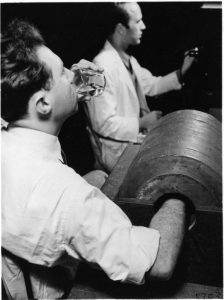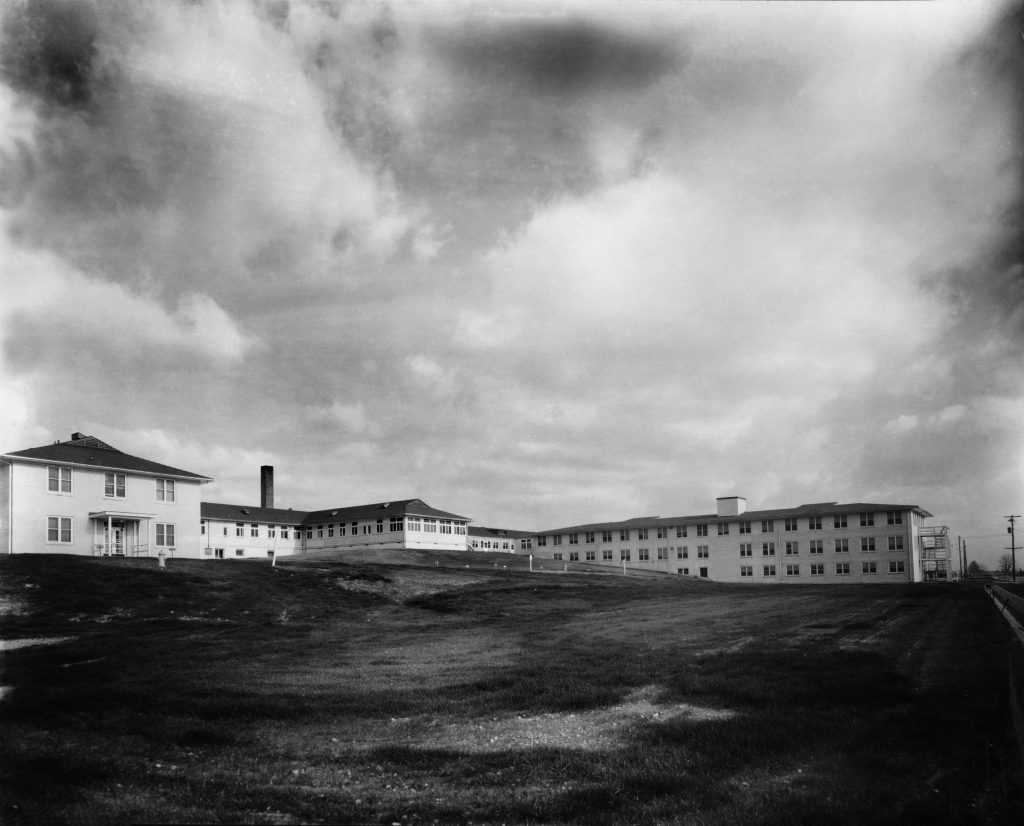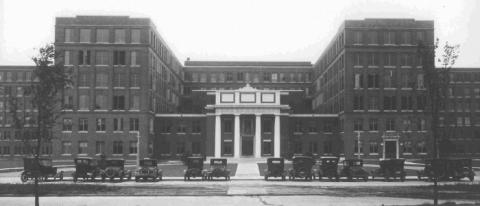Unknown Risks
Manhattan Project personnel faced many issues working with recently discovered elements whose health effects were unknown. Scientists at the time had little understanding of the biochemical effects of plutonium or uranium, even as they and others attempted to build a bomb with these very elements.
Manhattan Project leaders understood the urgency of measuring the impact of radiation on workers and established a Health Division in 1942. The concern was due to both the nature and the scale of the Project. Dr. Robert Stone, the health director at the Chicago Metallurgical Laboratory during the war, wrote in 1943, “Never before has so large a collection of individuals been exposed to so much radiation.” Faced with the unknown dangers of radioactive materials, General Leslie Groves hired Dr. Stafford Warren, a radiologist from the University of Rochester, as the Chief Medical Officer of the Manhattan Engineer District in 1942. The health division had three main objectives: to protect the health of Project workers, protect the public from any risks arising from the operation of the Project, and study radiation hazards in order to establish tolerance doses and devise methods of treatment. The Division was split into four sections: a Medical section, a Health Physics section, a Biological Research section, and a Military section.
At laboratories around the country, scientists began working against the clock to understand the dangers facing Manhattan Project workers and how to protect them. Data was taken from instruments, blood and urine samples, and physical exams. Radiation experiments were performed on animals at laboratories in Chicago, Berkeley, and Rochester. However, medical experts agreed that this information was not sufficient to determine radiation guidelines for workers. As a report from Los Alamos Laboratory scientists published in 1962 stated, “It seemed imperative, therefore, to determine retention and excretion of plutonium in a limited number of terminal patients.”
A New Protocol is Developed
By 1944 the medical team of the Manhattan Project, headed by Stafford Warren, concluded that a controlled experiment on humans was necessary. They came up with a plan to inject radioactive elements, including polonium, plutonium, and uranium, into civilian patients around the country. Between April 1945 and July 1947, eighteen subjects were injected with plutonium, six with uranium, five with polonium, and at least one with americium. The experiments were performed at Manhattan Project-affiliated hospitals in Rochester, New York; Oak Ridge, Tennessee; Chicago, Illinois; and San Francisco, California.

The materials were employed for different experimental purposes. The plutonium tests were intended to determine how excreta could be used to estimate the amount of plutonium remaining in an exposed subject. Scientists wanted to ascertain a method of determining how much radioactive material stayed in the body and for how long. These plutonium injections were given between 1945-1947 at the Manhattan District Hospital at Oak Ridge, the University of California San Francisco, the University of Chicago, and Strong Memorial Hospital in Rochester. The patient samples were then analyzed in affiliated labs nearby or shipped back to Los Alamos to be examined by a biomedical research team led by Dr. Wright Langham. The chemical process of determining the amount of plutonium in a sample was complex, requiring a contamination-free laboratory. The sample was dried, converted to ash, and finally dissolved in acid.
In Rochester, a Manhattan Annex was established in 1943 at the Strong Memorial Hospital to study the toxicity of radioactive isotopes including plutonium, uranium, and polonium. Between 1946-1947, physicians injected six patients with uranium with the research goal of discerning the minimum dose that would produce detectable kidney damage. This was an experimental protocol intended to produce a harmful reaction in the subjects.
Scientists at the time agreed that these experiments furthered the field of nuclear physics and provided practical insight into the quantitative limits of these elements in humans. The model relating body burden to short-term excretion rate is known as the “Langham” model after Wright Langham and is still used today. Nonetheless, questions have since been raised about the effectiveness of human experimentation during this period. The subjects chosen varied, and often the follow-up research was not thorough. Samples were contaminated or destroyed in transport on multiple occasions. Furthermore, the ethical issues involved were not given due attention.
Secrecy
From the beginning, these experiments were conducted under a high level of secrecy. As the Cold War began, Americans were frightened of an all-out nuclear war with the Soviet Union, and so the military and the scientists involved continued to operate with a wartime mentality. Additionally, the nature of the experiments was highly controversial, even among Manhattan Project scientists.
The secrecy started at the highest levels of the Manhattan Project. Plutonium and uranium were classified elements, referred to by code name only. Los Alamos Laboratory Director J. Robert Oppenheimer was informed of the nature of the experiments, but expressed in a 1944 letter to Louis Hempelmann, Director of the Health Group at Los Alamos, that he did not want the experiments carried out at the New Mexico facility. There is also evidence that Oppenheimer approved shipments of plutonium and uranium to be used for medical research. Reports show that many of the physicians themselves were unaware of the exact substance they were injecting into patients. The overall compartmentalization of the Project makes it difficult to trace the chain of command concerning these experiments. However, there is significant documentation that the medical and health directors at all sites were somehow invested in this research.
Hymer Friedell was the first army doctor assigned to the Manhattan Project and was placed at the Oak Ridge site as the Deputy Health Director under Stafford Warren. Friedell and Warren were charged with the health and safety of the Project as a whole. Friedell himself oversaw the first human injection of plutonium at Oak Ridge. In a letter to Hempelmann, Friedell wrote, “I think that we will have access to considerable clinical material here, and we hope to do a number of subjects.”
 Hempelmann met with Warren to approve a research program on human and animal subjects early in 1944. By the end of August of that same year, Hempelmann, Warren, and Oppenheimer decided to move forward with a medical research program on plutonium that would involve human subjects. Hempelmann received reports of the human injections through 1947, including the ongoing analysis of samples at Los Alamos Laboratory.
Hempelmann met with Warren to approve a research program on human and animal subjects early in 1944. By the end of August of that same year, Hempelmann, Warren, and Oppenheimer decided to move forward with a medical research program on plutonium that would involve human subjects. Hempelmann received reports of the human injections through 1947, including the ongoing analysis of samples at Los Alamos Laboratory.
Wright Langham was stationed first at the Chicago Met Lab and later at Los Alamos as an analytical chemist. Along with his team, he examined the samples shipped to him from Rochester and Oak Ridge. Correspondence between Langham and doctors in these two locations show that he played a major role in deciding the amount of doses, number of patients, and choice of subjects.
At the University of California, Joseph Hamilton oversaw the injection of three subjects. Hamilton had already performed tracer studies to determine plutonium toxicity in rats and discovered that contamination of the bloodstream was the most dangerous. Robert Stone held a parallel position at the University of Chicago Met Lab during the war, where three additional patients were given plutonium treatments.
The toxicity of radioactive elements was the main research concern at the University of Rochester Manhattan Annex. There, Dr. Samuel Bassett was the primary physician-investigator in the “Special Problems Division.” Rochester was the site of the most injections during this period. Bassett oversaw a two-bed ward, divided from the Strong Memorial Hospital.
A memorandum from the Atomic Energy Commission dated April 1947 recommended that human experimentation not be made public because, “It might have an adverse effect on public opinion or result in legal suits.” Out of this fear, the results of this research were largely kept hidden. When the AEC replaced the Manhattan District in 1947, the protocol was in fact reformed to require documentation of patient consent and “reasonable hope” that the substance would be of medical benefit to the patient. These guidelines came too late, and doctors continued to study samples from the original thirty patients without informing them why.
The Subjects
It is most likely that the 30 experimental subjects were not made aware of the nature of the injections they received. In fact, records show that only one of the plutonium patients signed a consent form, which did not fully explain the medical procedure or risks. There is no documentation of consent for any other test subjects.
Furthermore, it is difficult to say how the specific patients involved in these controlled human experiments were chosen. The injections were performed in hospitals around the country; the ages and backgrounds of each varied. Some had family and others were alone. Regardless, the records show that they were all civilians and were not themselves Manhattan Project workers. In order to understand the troubling nature of this research, it is important to highlight the stories of some of these test subjects.
Ebb Cade was the first test subject. Cade was a 53-year-old African American male who worked for an Oak Ridge construction company as a cement mixer. On March 24, 1945, he was involved in an auto accident, which caused fractures in his arm and leg. Documents from the time show that he was otherwise healthy. Over the next two weeks, he was given the codename HP-12, with HP standing for Human Product. Dr. Friedell wrote to Dr. Hempelmann at Los Alamos that he had found a primary subject for the plutonium experiment.
On April 10, 1945, Dr. Joseph Howland administered a plutonium dose of 4.7 micrograms to Cade, who was awaiting a procedure to set his bones. From 1943-1945, the maximum possible body burden (MPBB) for plutonium had been 5 micrograms, based on limits adopted for radium. Based on animal experimentation, Langham and Friedell had recently concluded that because plutonium remained in the bone for longer than radium, the MPBB should actually be set at 1 microgram. Cade’s dose was nearly five times that limit.
Cade was not treated for his arm and leg injuries until April 15, five days after the injection, so that the doctors would be able to biopsy his bone samples. This included extracting 15 of his teeth, which were subsequently shipped to Wright Langham at Los Alamos. It is unclear if Cade suffered from legitimate tooth decay. Shortly after his bones had been set, Cade suddenly discharged himself from the hospital. He moved out of Tennessee and died of heart failure on April 13, 1953, 8 years after the Oak Ridge injection.
CAL-1 was the codename given to Albert Stevens, the first patient to receive a plutonium dose in California. He was a 58-year-old house painter who was misdiagnosed with terminal stomach cancer when he checked into the hospital at the University of California, San Francisco (UCSF). The doctors at UCSF initially gave him six months to live. Doctors in Joseph Hamilton’s research group at Berkeley prepared plutonium-238, an isotope that is 276 times more radioactive than the plutonium-239 and therefore easier for instruments to measure (Welsome, 91).
On May 14, 1945, one month after the Oak Ridge injection, Albert Stevens unknowingly received a dose of plutonium that was considered “carcinogenic” by a scientist in Hamilton’s lab. He was taken to surgery a few days later for doctors to remove parts of his internal organs. A biopsy shortly after revealed that the ulcer doctors had initially diagnosed as cancer was in fact benign. Doctors continued to monitor Stevens after he left the UCSF hospital without providing any explanation. Stevens and his family were never informed that he did not have cancer. He died in 1966 of heart failure, 21 years after entering the UCSF hospital.
 Eda Schultz Charlton, a 49-year-old woman known in reports as HP-3, was admitted to Strong Memorial Hospital in Rochester on November 2, 1945 for unusual swelling. She was transferred to E-3 ward which was led by Dr. Samuel Bassett. Three weeks later she received a plutonium injection of 4.9 micrograms. There is no mention of this procedure in her hospital records, only in Manhattan Project reports. The decision to separate experimentation notes from medical charts was made by Stafford Warren himself, as mentioned in a 1946 letter from Wright Langham to Samuel Bassett.
Eda Schultz Charlton, a 49-year-old woman known in reports as HP-3, was admitted to Strong Memorial Hospital in Rochester on November 2, 1945 for unusual swelling. She was transferred to E-3 ward which was led by Dr. Samuel Bassett. Three weeks later she received a plutonium injection of 4.9 micrograms. There is no mention of this procedure in her hospital records, only in Manhattan Project reports. The decision to separate experimentation notes from medical charts was made by Stafford Warren himself, as mentioned in a 1946 letter from Wright Langham to Samuel Bassett.
Charlton was discharged on December 20, 1945; however, doctors continued to collect X-Rays and tissue samples for studies. Charlton was regularly hospitalized until her death by cardiac arrest in 1983, almost forty years after the injection. Her case is puzzling because she was never diagnosed as terminally ill. Reports mention that there was an error in her diagnosis, but it is unclear why she was ever moved to Bassett’s ward in the first place. Her regular metabolism, however, provided an ideal case study for research into how healthy people excrete plutonium.
Another questionable case was CAL-2, a four-year old boy named Simeon Shaw suffering from terminal bone cancer. He was flown with his mother to the UCSF hospital in a US military plane from Australia, apparently under the advisement of a physician in Australia. He arrived in California in April 1946 and was admitted to the hospital. For some time, he was separated for his mother, who was only allowed visits periodically. Simeon received a plutonium injection at UCSF under the oversight of Joseph Hamilton and was discharged from the hospital within a month. The Shaws returned to Australia and no follow-ups were ever conducted. Simeon died eight months later.
The physicians involved knew that the procedures had no therapeutic benefits and would be detrimental in the long run if the patients lived. Human experimentation was justified by the claim that the patients were terminally ill; however, this was not true in all cases. Repeated errors in diagnosis, procedure, documentation, and research were made, ultimately calling into question the efficacy of the experiments themselves.
Cold War Human Experiments

Human experimentation continued throughout the Cold War. There is evidence of several large-scale projects across the country that also failed to inform patients of the health hazards of these experiments. At the Fernald School in Massachusetts, a school for disabled and special needs children, students were exposed to radioactive iron and calcium in the late 1940s and 1950s in a federally sponsored study. Their parents were not informed of the full nature of these experiments.
Between 1953-1957, Oak Ridge National Laboratory conducted uranium injection experiments on eleven patients at Massachusetts General Hospital as part of their continued Health Physics research. Scientists discovered that uranium localized in human kidneys at a much higher rate than previously thought, and therefore that maximum permissible levels were too high. Despite the efforts of this experiment, however, occupational standards for uranium did not change at any national laboratories.
Other large scale, federally sponsored research was performed on prisoners in Washington and Oregon state prisons and on pregnant women at Vanderbilt University. Like human injections from 1945-1947, these experiments took advantage of vulnerable populations who were not given sufficient details to give informed consent. You can read more about the continuation of human experiments here.
Legacy and Ethics

In the early 1990s, the Albuquerque Tribune uncovered the nature of these human experiments and the identity of the patients. In response, President Bill Clinton set up an Advisory Committee on Human Radiation Experiments. The Department of Energy, under the leadership of Secretary Hazel R. O’Leary, undertook an extensive investigation into all aspects of these experiments since the start of the atomic age.
Thousands of documents were declassified and several hearings were held. In 1995, the DOE released a report which detailed the experiments, made ethical judgments, and gave recommendations to Congress on how to proceed. At this time, the subjects of the 1945-1947 tests had passed away. Families of the victims received payments from the federal government. By 1997, laws were adopted to prohibit secret scientific testing on humans. New legislation required patients to give informed consent and to be notified if experiments were classified. Additionally, the government stipulated that thorough documentation was to be kept and externally reviewed.
In November 1986, the Congressional Subcommittee on Energy Conservation and Power released a report called American Nuclear Guinea Pigs: Three Decades of Radiation Experiments on US Citizens, which included details about human experiments during the Manhattan Project. However, until the Department of Energy investigation in 1994, most of the American public was unaware of these experiments.
According to the 1995 Advisory Committee on Human Radiation Experiments report, “In no case was there any expectation that these patient-subjects would benefit medically from the injections.” In most cases, rather, the injections had a significantly greater adverse effect than originally hypothesized. For example, scientists originally thought that 90% of the material would be excreted by subjects. However, a 1946 study coauthored by Edwin Russell and James Nickson titled “Distribution and Excretion of Plutonium” disclosed that excretion studies showed that nearly 90% of the plutonium entering the body is retained for years in the bone.
Furthermore, the doctors misdiagnosed many of their patients as terminal when they in fact were not. The physicians involved violated the medical responsibility to “First, do no harm” by hiding the nature of the injections from their patients. The DOE report concludes that the experiments were unethical: “The egregiousness of the disrespectful way in which the subjects of the injection experiments and their families were treated is heightened by the fact that the subjects were hospitalized patients. Their being ill and institutionalized left them vulnerable to exploitation.” The stories of men and women like Ebb Cade, Albert Stevens, Eda Charlton, and Simeon Shaw are a reminder of the weighty costs associated with medical and scientific progress.
When the documentation concerning human experimentation came to light in the mid-1990s, one journalist wrote that this information “will force historians to rewrite part of the history of the dawn of the atomic age.” It is important to critically consider the role of human experimentation in the legacy of the Manhattan Project.





